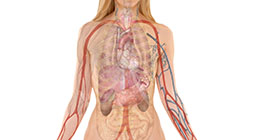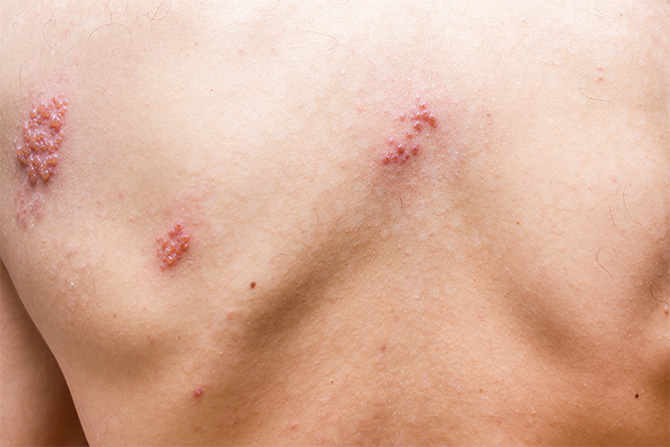Overview
Symptoms
Causes
Prescription
Health Tips
Around 130,000 Canadians will contract shingles each year and rates are on the rise, although researchers are not exactly sure why. Chickenpox (varicella zoster virus) is a childhood ailment that produces an itchy rash and fever. It is not likely to cause serious harm, although some children may experience secondary infections. The virus becomes latent in the nervous system and remains that way unless conditions cause the virus to reactivate in the body causing shingles.
Those who are immune compromised or under constant stress are at a higher risk of developing shingles. The virus reaches the tips of the nerves and signals the brain to feel itching and burning sensations and severe pain. If the pain lingers for several weeks to months following a bout of shingles, it is called postherpetic neuralgia and is experienced in 20 percent of herpes zoster cases. After the age of 50 those chances increase 15 times. Those with blisters and sores are contagious until sores have crusted over and should avoid contact with people who have not had chickenpox in the past.
Symptoms
Shingles can affect any area of skin but is more prevalent in the area under the ribs and the nerves of the face and neck.
- A rash will develop a few days after initial pain begins
- Appearance of red, fluid-filled blisters and extreme pain
- After a week or two the blisters will erupt, dry up, scab over, and drop off
- Feelings of depression, numbness, swollen glands
- In postherpetic neuralgia, the skin can be so sensitive that wind, clothing, and bedding can feel extremely painful
- Pain, stinging, burning, or itching sensations on one side of the body
- Shingles that involves the eyes is a medical emergency and a physician should immediately be consulted
- Some experience fever, body aches, headaches and chills
Causes
The virus herpes zoster or varicella-zoster causes shingles and chickenpox. Only those who have had chickenpox are at risk of developing shingles. Herpes zoster will happen once and then there appears to be immunity, with less than 5 percent contracting it a second time. It usually attacks after the age of 50 because that age group begins to show a decrease in T-cell immunity. Those with a weakened or compromised immune system are at a greater risk of developing shingles, as are those with autoimmune diseases such as multiple sclerosis, lupus, or Crohn’s disease. Prolonged periods of emotional or physical stress or trauma may negatively affect the immune system and trigger reactivation in some people.
Prescription for Health
Antiviral medications such as Valtrex and Zovirax can slow the intensity and length of the outbreak if taken within the first 72 hours of infection.
Diet
Arginine and lysine are two amino acids that are both important to general health. However, those with shingles should avoid foods with high arginine to lysine ratio. Arginine can aid the virus and make the infection worse. Lysine, on the other hand helps to inhibit the virus.
High arginine, low lysine foods:
- Nuts and seeds (pumpkin seeds, peanuts, sunflower seeds, etc.)
- Shellfish
High lysine, low arginine foods:
- Avocado
- Beef
- Cheese
- Chicken
- Fish
- Yogurt
In addition, foods that help to support the immune system and reduce inflammation should be added to the diet. This includes vegetables, fruits, whole grains that are high in lysine such as buckwheat, quinoa, and amaranth; fish and healthy fats also contain lysine. Processed foods, refined carbohydrates, sugars, fried foods and poor-quality fats (margarine, canola oil, rancid fats) should all be avoided as they hinder the immune system and increase inflammation in the body which may slow recovery time.
| Nutrient | Dosage | Action |
|---|---|---|
| Lysine | 1000 mg three times daily until sores are gone, then 500 – 1000 mg thereafter for prevention | Shrinks blisters, reduces recurrence, keeps arginine in balance |
| Vitamin C | IV vitamin C or 1000 mg of vitamin C every waking hour until sores are gone, then take Multimune containing vitamin C and other antioxidants for maintenance | Enhances immune function and prevents virus from replicating |
| High-potency B-complex and vitamin B12 | 100 mg of B-complex three times daily, 500 mcg of B12 every waking hour or 1000 mcg B12 injection three times per week until sores are gone. Then take 500 mcg daily for maintenance | Protects against the effects of stress. B12 helps with postherpetic neuralgia and shrinking of blisters. B12 injections have been shown to shorten the duration of shingles. |
| Vitamin E | 400 IU of vitamin E three times daily for three days | Shrinks and heals blisters quickly, stops postherpetic neuralgia |
| Bioflavonoids | 500 mg every waking hour until sores are gone, then 500 mg daily thereafter | Works with vitamin C |
| Fucoidans | 500 mg twice daily | Speeds healing and inhibits lesions from reactivation and growth |
| Zinc citrate | 30 mg daily until sores are gone, then take Multimune containing 15 mg of zinc | Prevents infection and boosts immunity |
| CoQ10 | 60 mg daily until sores are gone. | Helps immune system fight viruses |
| Homeopathic Rhus Tox 12C | Three pellets three times daily until sores are gone | Stops virus and enhances immune function |
| Wobenzym | Three capsules daily on an empty stomach | Deactivates viruses |
| Capsaicin cream | 0.075 cream applied to rash several times daily | Shortened duration and faster healing |
| Cimetidine (Tagamet) | 300 mg three times daily and 400 mg at night | Shortened duration and faster healing |
Health Tips to Enhance Healing
- Apply capsaicin cream to rash.
- Apply cold compresses to blisters.
- Avoid wearing tight and synthetic clothing; instead wear loose clothing made of natural materials.
- Do not scratch rash; wash hands after touching.
- Get lots of rest and sleep.
- Put aside focus on pain by watching movies, working on a hobby, listening to music, or reading.
- Reduce and avoid stress.
- Take warm oatmeal baths.











